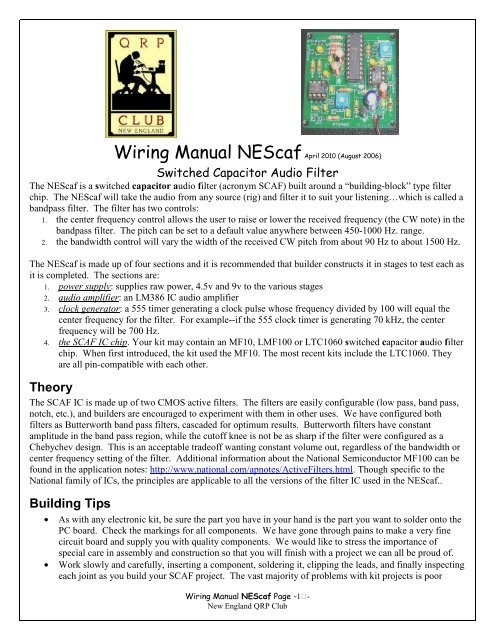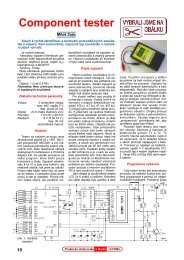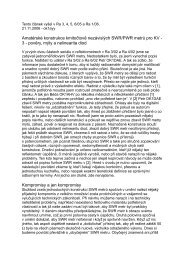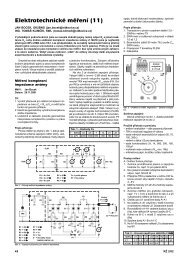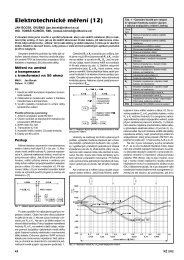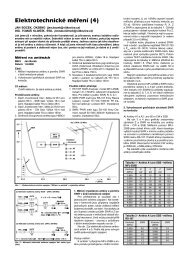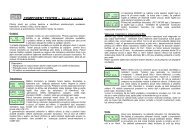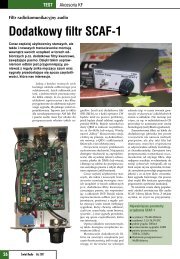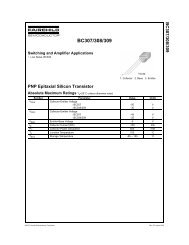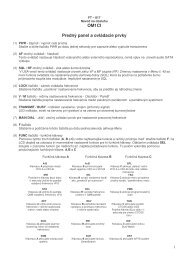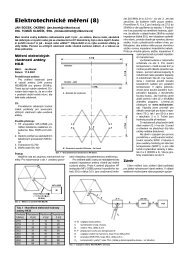Theory Building Tips
Theory Building Tips
Theory Building Tips
Create successful ePaper yourself
Turn your PDF publications into a flip-book with our unique Google optimized e-Paper software.
Wiring Manual NEScaf April 2010 (August 2006)<br />
Switched Capacitor Audio Filter<br />
The NEScaf is a switched capacitor audio filter (acronym SCAF) built around a “building-block” type filter<br />
chip. The NEScaf will take the audio from any source (rig) and filter it to suit your listening…which is called a<br />
bandpass filter. The filter has two controls:<br />
1. the center frequency control allows the user to raise or lower the received frequency (the CW note) in the<br />
bandpass filter. The pitch can be set to a default value anywhere between 450-1000 Hz. range.<br />
2. the bandwidth control will vary the width of the received CW pitch from about 90 Hz to about 1500 Hz.<br />
The NEScaf is made up of four sections and it is recommended that builder constructs it in stages to test each as<br />
it is completed. The sections are:<br />
1. power supply: supplies raw power, 4.5v and 9v to the various stages<br />
2. audio amplifier: an LM386 IC audio amplifier<br />
3. clock generator: a 555 timer generating a clock pulse whose frequency divided by 100 will equal the<br />
center frequency for the filter. For example--if the 555 clock timer is generating 70 kHz, the center<br />
frequency will be 700 Hz.<br />
4. the SCAF IC chip. Your kit may contain an MF10, LMF100 or LTC1060 switched capacitor audio filter<br />
chip. When first introduced, the kit used the MF10. The most recent kits include the LTC1060. They<br />
are all pin-compatible with each other.<br />
<strong>Theory</strong><br />
The SCAF IC is made up of two CMOS active filters. The filters are easily configurable (low pass, band pass,<br />
notch, etc.), and builders are encouraged to experiment with them in other uses. We have configured both<br />
filters as Butterworth band pass filters, cascaded for optimum results. Butterworth filters have constant<br />
amplitude in the band pass region, while the cutoff knee is not be as sharp if the filter were configured as a<br />
Chebychev design. This is an acceptable tradeoff wanting constant volume out, regardless of the bandwidth or<br />
center frequency setting of the filter. Additional information about the National Semiconductor MF100 can be<br />
found in the application notes: http://www.national.com/apnotes/ActiveFilters.html. Though specific to the<br />
National family of ICs, the principles are applicable to all the versions of the filter IC used in the NEScaf..<br />
<strong>Building</strong> <strong>Tips</strong><br />
• As with any electronic kit, be sure the part you have in your hand is the part you want to solder onto the<br />
PC board. Check the markings for all components. We have gone through pains to make a very fine<br />
circuit board and supply you with quality components. We would like to stress the importance of<br />
special care in assembly and construction so that you will finish with a project we can all be proud of.<br />
• Work slowly and carefully, inserting a component, soldering it, clipping the leads, and finally inspecting<br />
each joint as you build your SCAF project. The vast majority of problems with kit projects is poor<br />
Wiring Manual NEScaf Page -1-<br />
New England QRP Club
solder joints. Heat first…count to 3 and then add solder. Apply a small amount of solder to the angle<br />
formed by the soldering tip, component lead and the circuit board. Do not remove the tip until solder<br />
has flowed completely around the circuit board pad and the component lead, and then slide the tip away<br />
from the board a short distance as you remove your iron. If you’re new to soldering, practice makes<br />
perfect. Try it.<br />
• Several parts for the NEScaf are sensitive to static discharge which include the integrated circuits (ICs).<br />
Take precautions to ground yourself prior to and while handling those sensitive parts by touching a<br />
ground point BEFORE handling them. Your body DOES hold a charge. DISCHARGE IT!<br />
• When describing orientation for part insertion, we assume that the builder is looking at the PC board<br />
with the “audio in” stencil to the builder’s left, and audio out to the right.<br />
• Due to parts availability, your 2 trimmer pots may have leads in a straight line or a triangle pattern. The<br />
leads should be carefully bent by inserting one “end” lead into the appropriate hole in the board, then<br />
gently twisting the body of the trimmer until the next lead lines up with its hole, then repeat for the third<br />
lead. Push down gently to seat the leads in their holes. The trimmer will not sit flush against the board,<br />
but rather above the board by about 1/8 to ¼ inch.<br />
Stage Ø: The Layout<br />
If IC sockets are used (highly recommended), insert them first. When inserting the socket for IC1, be<br />
careful to move it away from R1, R2, and R3 and toward R4 to make soldering easier later. Also check<br />
each joint on this socket very carefully (measure it with an ohm meter if needed) to ensure all pins are<br />
soldered well. A few minutes spent here may save anguished time later.<br />
Stage 1: The Power Supply<br />
Insert the following components (recommended in this order) onto the PC board. Foil side is down and stencil<br />
side is up. Insert components on the stencil side.<br />
[ ] R15 4.7k Ω (yellow, violet, red)<br />
[ ] C15 .33µF (334)<br />
[ ] R11 10 Ω (brown, black, black) (Don’t be confused with 10k! Use ohm meter to check.)<br />
[ ] C1 4.7µF electrolytic (observe polarity-short leg is negative)<br />
[ ] C2 4.7µF electrolytic (observe polarity-short leg is negative)<br />
[ ] C5 .1µF (104)<br />
[ ] R17 10k Ω (brown, black, orange)<br />
[ ] R18 10k Ω (brown, black, orange)<br />
[ ] C16 .1µF (104)<br />
[ ] C11 100µF electrolytic (observe polarity-short leg is negative)<br />
[ ] C19 .1µF (104)<br />
[ ] IC4 78L09 9v regulator - handle carefully and insert with correct orientation. Preform, if necessary<br />
Wiring Manual NEScaf Page -2-<br />
New England QRP Club
Prior to applying voltage power, check the resistance with an ohm meter between the Vcc (positive side of<br />
power) and GND (ground) connections. The resistance reading should indicate some amount of resistance<br />
other than a short (the exact value will depend on your meters impedance). If the reading is shorted (zero<br />
ohms), do not apply power but check all your work for solder bridges to ground!<br />
Connect a red wire to the Vcc input on the circuit board, and black wire to the ground pad. The length will be<br />
determined by the builder’s enclosure needs. Note also that the NEScaf has no reverse polarity protection, such<br />
as a diode, or fusing. Builders are advised to exercise great care when connecting power to the circuit.<br />
Connect power to the circuit board—Vcc (11.5 to 13.8 v). Nominal power of 12v. is expected for the NEScaf,<br />
but voltage down to 11.5 volts should still work. Positive voltage is connected to the red lead, and black lead<br />
negative (GND) is attached to the ground lead.<br />
Check the following pin connections to ground.<br />
[ ] IC1 pin 6 = 9vdc<br />
[ ] IC1 pin 7 = 9vdc<br />
[ ] IC1 pin 8 = 9vdc<br />
[ ] IC1 pin 5 = 4.5vdc<br />
[ ] IC1 pin 12 = 4.5vdc<br />
[ ] IC1 pin 15 = 4.5vdc<br />
[ ] IC1 pin 16 = 4.5vdc<br />
[ ] IC2 pin 6 = Vcc supplied to board<br />
[ ] IC3 pin 4 = 9vdc<br />
Turn off the power and move on to stage two—audio amplifier.<br />
Stage 2: Audio Amplifier<br />
Insert the following components—NOTE: C3 has been changed from 10µF to 100µF. Due to it’s slightly<br />
larger size, it is recommended to install the components in this order. C3 may sit slightly above the<br />
board due to it’s lead spacing. This will not affect filter performance.<br />
[ ] C18 4700pf (472)<br />
[ ] R20 15k Ω (brown, green, orange)<br />
[ ] C9 1µF (105) This is a tantalum cap and is polarized. The hard to see black stripe points to the<br />
positive lead. Insert with the positive lead closest to IC1. Do not clip the positive lead on<br />
this capacitor after soldering, as it will be used to test the circuit when done.<br />
[ ] C10 .01µF (103)<br />
[ ] C12 .1µF (104)<br />
[ ] R12 10 Ω (brown, black, black) (Don’t be confused with 10k! Use ohm meter to check.)<br />
[ ] C3 100µF electrolytic (was 10µF - observe polarity-short leg is negative)<br />
[ ] R14 10k Ω trimmer pot ( you may need to gently move the legs to position this on the board.)<br />
[ ] IC2 LM386 – Makes sure IC pins are parallel to each other when inserting into socket, if used.<br />
Pin one is marked by a circular indentation on the top of the IC package and it should be<br />
placed toward the center of the circuit board.<br />
**If you have an audio oscillator near by, connect it to the positive lead of C9, farthest away from IC1. Should<br />
an audio oscillator not be available, any audio source will do (audio from another rig for instance). Be sure to<br />
ground the audio oscillator or audio source onto the PCB. Connect a speaker or low impedance headphones<br />
Wiring Manual NEScaf Page -3-<br />
New England QRP Club
etween the ‘audio out’ connection and ground; apply power. You should hear an audio tone. Now apply the<br />
same audio tone to pin 19 on IC1, (IC 1 MP10/100 should not be inserted yet). Audio should be heard in the<br />
speaker. Adjust R14 to ensure it varies the volume and set it to approximately ¼ turn clockwise (cw).<br />
Once the SCAF filter is complete, R14 will adjust the volume output for the filter. We chose a design which<br />
would provide for unity gain, inasmuch, when the filter is turned on or off, the volume output does not change.<br />
If SW1 is wired as recommended, the NEScaf may be left inline between the rig of choice and the user’s<br />
speaker or headphones, and audio will bypass the NEScaf to the output when the SCAF filter is off. Some<br />
builders may choose to replace R14 with a panel mounted potentiometer to allow controlling the NEScaf<br />
volume.<br />
Stage 3: Clock Generator<br />
Insert the following components--<br />
[ ] C6 .001 µF (102) - This is an NPO capacitor and is critical in the design. Substituting a non-<br />
NPO capacitor may allow the filter center frequency to shift. The cap supplied is an “axial”<br />
type, leads extending from each end. One lead can be gently bent back over the body of the<br />
cap, and the cap mounted vertically on the board. This may be easier than bending the leads<br />
to fit the hole spacing on the board..<br />
[ ] C8 .01µF(103)<br />
[ ] C7 1µF (105) Tantalum - observe polarity with positive away from IC1.<br />
[ ] R8 2k Ω (red, black, red)<br />
[ ] R9 10k Ω pot (perform component leads to positioned onto PC board)<br />
[ ] IC3 555 timer IC. Makes sure pins are parallel to each other when inserting into socket, if used.<br />
[ ] R10 10k Ω off-board potentiometer with detent.. Center connection (wiper) connects to R10_w<br />
and left hand connection, looking from front, connects to R10 on PC board. This will cause<br />
cw (clockwise) turning to correspond decreasing resistance, and as a result increasing<br />
frequency. The right tab and center wiper tab on the pot are connected together with a short<br />
piece of wire.<br />
Applying power should produce about 70kHz on pins 10 and 11 of IC1 (without MF100 IC chip inserted). This<br />
should be easily detected with a scope or a frequency counter. The 555 clock will be about 9v peak-to-peak so<br />
be careful connecting the leads to a frequency counter that it does not overload or damage the input.<br />
A careful observation will show that there are two potentiometers setting the frequency of the oscillator and by<br />
extension, the center frequency of the band pass of the filter. The frequency of the IC-555 is 100 times the<br />
center frequency of the filter. A frequency of 70 kHz for the IC-555 circuit will result in a center frequency of<br />
700 Hz. for the filter overall. The on-board trimmer pot is used to allow the center frequency, selected by the<br />
user, to correspond to the detent position of the off-board potentiometer. Further discussion follows for setting<br />
the center frequency once the SCAF filter is complete.<br />
Stage 4 The Scaf Filter<br />
Insert the following components--<br />
[ ] R2 27k Ω (red, violet, orange)-- red and orange are easy to confuse; measure with an ohm meter.<br />
[ ] R1 2.7k Ω (red, violet, red)<br />
[ ] R3 27k Ω (red, violet, orange)<br />
[ ] R5 27k Ω (red, violet, orange)<br />
[ ] R4 2.7k Ω (red, violet, red)<br />
Wiring Manual NEScaf Page -4-<br />
New England QRP Club
[ ] R6 27k Ω (red, violet, orange)<br />
[ ] C17 1µF (105)<br />
[ ] R7 Panel mounted, dual gang 50k Ω potentiometer-Take care that the wiper<br />
connection (middle pin on pot) goes to the designated W connections on<br />
circuit board. The circuit board is labeled R7a and R7a_w for the first<br />
'gang' or section, and R7b and R7b_w for the second. The W stands for wiper<br />
(middle tab on each potentiometer section). Looking at the front of the<br />
potentiometers, connect the center tab of each gang to the correct circuit<br />
board location labeled W. The center tab (wiper) and the left tab are<br />
connected together with a short piece of wire. Next, connect the right tab<br />
of each gang to the correct circuit board location for each gang( R7a and<br />
R7b). So, if you connect the center tab (wiper) of the pot section closest<br />
to the shaft to R7a_w, then connect the right tab of that same pot section<br />
to R7a. Twist the two leads to each pot separately as it makes it easier to<br />
keep track on the PCB. Some components already mounted on the circuit board<br />
might ‘hide’ the W so be familiar with the PC board layout.<br />
[ ] IC1 MF10, LMF100 or LTC1060 IC chip Make sure pins are parallel to each other when inserting (if<br />
using sockets) and pin 1 is toward the top of the PC board.<br />
The SCAF filter at this point could be connected to an audio generator at the SCAF audio input point. Connect<br />
a small speaker to the audio output (using the appropriate grounds); connect power; the tone should be audible<br />
to your ear. If there is no audio, turn the bandwidth potentiometer (double pot) extreme left or right, and then<br />
turn the center frequency pot to hear audio At this point, you should hear an audio signal..<br />
Stage 5 Final Things<br />
The NEScaf should now be fully populated. Some panel connections need to be made.<br />
• DPDT SW1: This switch is two switches in parallel: one to control power to the NEScaf and the other to<br />
control audio to the headphones. (See below.) Section A controls power, with the center connection<br />
coming from the battery to the unit. The lower contact of section A will be connected to Vcc on the PC<br />
board. The upper contact of section A is not connected--nc. Section B controls audio with the center tab<br />
from the audio source—the rig. The lower connection of section B will connect to ‘audio in’ on the<br />
NEScaf circuit board. The upper connection of section B will go to the ‘audio out’ on the NEScaf<br />
connector--to the headphones. The ‘audio out’ of the circuit board should also be connected to the ‘audio<br />
out’ connector to the headphones. Connected this way, and when power is on, ‘audio in’ is routed from<br />
the rig through the switch to the audio input of the NEScaf. When power is off, ‘audio in’ is routed<br />
directly to the ‘audio out’ connector--the headphones.<br />
Figure 1 SWITCH #1 DPDT<br />
Review your wiring.<br />
Wiring Manual NEScaf Page -5-<br />
New England QRP Club
[ ] Mount audio connectors: as desired.<br />
[ ] Mount LED power indicator.<br />
• LED POWER INDICATOR. An LED is provided in the standard kit and can be connected to the PC<br />
board. Observe polarity (shorter lead to circuit board ground). The LED can be panel mounted, board<br />
mounted, or omitted altogether. It will light when DC power is on and the SCAF is functional.<br />
• AUDIO CONNECTORS: Two portable radio size, female audio connectors are supplied in the<br />
optional connector kit. One audio connector soldered to the audio input of the DPDT switch and the<br />
other audio connector is soldered to the ‘audio output’ on the NEScaf PC board. Ground connections<br />
should be made to the appropriate points on the circuit board.<br />
• POWER CONNECTION: A standard 2.1mm x 5.5mm power connector is provided in the optional<br />
connector kit. Note that often the GND is connected to the outside pin and positive to the center pin.<br />
Also note that no fusing or reverse power protection diode is provided with the NEScaf. Caveat builder<br />
and be careful!<br />
Once the filter has all the appropriate connections, the two on board potentiometers can be adjusted for<br />
optimal use:<br />
• R10 adjusts the center frequency of the filter. Connect the NEScaf filter to the audio output of your<br />
favorite rig, and set the rig to produce its side tone. Set the bandwidth of the NEScaf filter to its widest<br />
position. Now, set the center frequency panel potentiometer to its detent position. The side tone should<br />
be heard on the output speaker or headphones. Slowly narrow the bandwidth with the BW (bandwidth)<br />
potentiometer, and adjust R10 to keep the side tone audible. When the bandwidth is its narrowest<br />
setting, peak the audio heard with R10. The filter is now centered for the rig of choice. The NEScaf can<br />
also be used as a ‘zero beat’ tool at its narrowest setting.<br />
• R14 adjusts the audio volume out from the NEScaf. If SW1 is wired as mentioned above, sound from<br />
the rig should be heard directly from the rig when the NEScaf is off, and the sound from the rig should<br />
be filtered and audible when the NEScaf is on. We have found it convenient to adjust R14 so that the<br />
audio volume is the same whether the filter is on or off. Easier on your ears in the long run.<br />
What if the SCAF does not work. [Troubleshooting] Suggestions…<br />
• Take a break and come back to it when you’re ready. Other hams have built the SCAF filter and have it<br />
working. You can too!<br />
• Reheat every connection on the bottom of the board to be certain you do not have a cold solder joint.<br />
Unfortunately, however, cold solder joints or a solder bridge are two of the most common mistakes in kit<br />
building. Be careful and work slowly and you’ll be rewarded! Don’t over do it with the solder.<br />
• Recheck the voltages on the ICs and reread the resistor placement for any misallocated parts.<br />
• Check each stage for proper operation one by one:<br />
• Power is okay? Voltages accurate?<br />
• With IC1 removed, does the audio amp work properly?<br />
• With IC1 removed, does the 555 clock generator work properly?<br />
• Check each of the connections from IC1 and carefully reheat if necessary.<br />
Beyond this builders have two resources: There is a forum for discussing problems (and accolades) on<br />
www.newenglandqrp.org. For problems beyond reason, email NEScafhelp@newenglandqrp.org. We do ask<br />
that email be sent there only after the forum has been tried first.<br />
Wiring Manual NEScaf Page -6-<br />
New England QRP Club
Parts List<br />
NT1U - v3.1 24 Aug 06<br />
K1LGQ 23Aug06<br />
Revised K1LGQ 03March08<br />
Revised N1RX 28April2010<br />
Part<br />
C1<br />
C2<br />
C3<br />
C5<br />
C6<br />
C7<br />
C8<br />
C9<br />
C10<br />
C11<br />
C12<br />
C15<br />
C16<br />
C17<br />
C18<br />
C19<br />
Value<br />
4.7µF 50v electrolytic<br />
4.7µF 50v electrolytic<br />
100µF 25v electrolytic<br />
.1µF<br />
.001µF (NPO)<br />
1µF tantalum<br />
.01µF<br />
1µF Tantalum<br />
.01µF<br />
100µF 25v electrolytic<br />
.1µF<br />
.33µF<br />
.1µF<br />
1µF Tantalum<br />
4700pf<br />
.1µF<br />
NOTE: C4, C13, and C14 were removed<br />
during design revisions.<br />
Part<br />
R1<br />
R2<br />
R3<br />
R4<br />
R5<br />
R6<br />
R7<br />
R8<br />
R9<br />
R10<br />
R11<br />
R12<br />
R14<br />
R15<br />
R17<br />
R18<br />
R20<br />
Value<br />
2.7k Ω (all resistors 1/4w)<br />
27k Ω<br />
27k Ω<br />
2.7k Ω<br />
27k Ω<br />
27k Ω<br />
Dual gang 50k Ω panel mounted<br />
potentiometers<br />
2k Ω<br />
10k Ω on board trimmer potentiometer<br />
10k Ω panel mounted potentiometer, with<br />
center detent<br />
10 Ω<br />
10 Ω<br />
10k Ω on board trimmer potentiometer<br />
4.7k Ω<br />
10k Ω<br />
10k Ω<br />
15k Ω<br />
NOTE: R13, R16, and R19 were removed<br />
during design revisions.<br />
Wiring Manual NEScaf Page -7-<br />
New England QRP Club
IC1<br />
IC2<br />
IC3<br />
IC4<br />
LED<br />
SW1<br />
MF10, LMF100 or LTC1060 SCAF<br />
LM386 Op amp<br />
555 timer<br />
78L09 regulator<br />
Green<br />
DPDT panel mounted switch<br />
Not included in basic kit:<br />
Audio connectors, (optional kit)<br />
Power connectors, (optional kit)<br />
IC sockets: 1 - 20 pin, 2 ea. 8 pins<br />
Enclosure<br />
Wiring Manual NEScaf Page -8-<br />
New England QRP Club
Wiring Manual NEScaf Page -9-<br />
New England QRP Club
Stencil Layout<br />
Wiring Manual NEScaf Page -10-<br />
New England QRP Club


